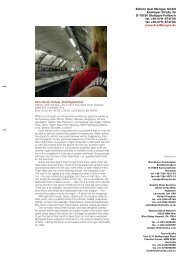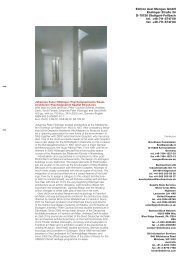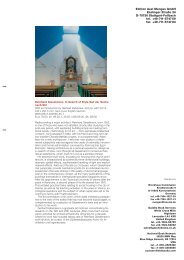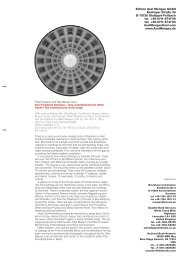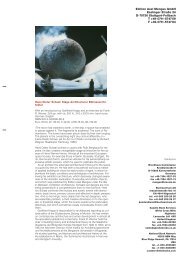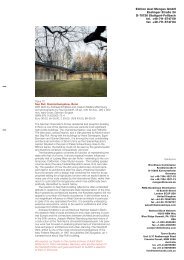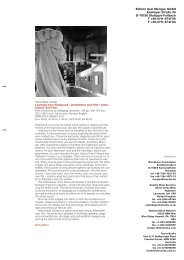Kulka, d - Edition Axel Menges
Kulka, d - Edition Axel Menges
Kulka, d - Edition Axel Menges
You also want an ePaper? Increase the reach of your titles
YUMPU automatically turns print PDFs into web optimized ePapers that Google loves.
Karin Kirsch<br />
The Weissenhofsiedlung. Experimental Housing<br />
Built for the Deutscher Werkbund, Stuttgart, 1927<br />
224 pp. with 460 illus., 230x290 mm, hard cover, English<br />
ISBN 978-3-936681-60-4<br />
Euro 79.00, £ 69.00, US$ 98.00, $A 119.00<br />
The fundamental significance of the Weissenhofsiedlung in Stuttgart<br />
for the history of early modern architecture should not be<br />
underestimated. Almost all the influential architects of the 20th<br />
century built their proposed solutions in response to the theme<br />
»a home for modern city dwellers« on the beautifully located slope<br />
on the north side of Stuttgart. The choice of architects and the<br />
fact that a project of this type could be implemented at all so few<br />
years after World War I and the inflation, is one of the outstanding<br />
characteristics of this building exhibition.<br />
»The German Werkbund is aware, and points out most emphatically<br />
that so important a task can only be successful and have<br />
a major impact if it is not only carried out in a technically flawless<br />
manner but also creates trendsetting architectonic solutions. The<br />
Werkbund therefore recommends to the city of Stuttgart that leading<br />
architects be commissioned with planning the exhibition and<br />
thus assuming a leading role in the construction of modern housing<br />
both in Germany and abroad.« This memorandum, dated January<br />
1926, concludes with the following appeal: »It is now up to<br />
the municipal council whether this event, so crucial for the promotion<br />
of our housing, will be able to take place in Stuttgart in 1927.«<br />
An interesting situation thus arose: Members of the municipal<br />
council belonging to all social classes had to decide on the merits of<br />
this pioneering project. The majority voted for it. The result is surprisingly<br />
unambiguous: 25 yes votes, 11 no votes and 6 abstentions.<br />
How did this project ever come to Stuttgart, anyway? What<br />
made it possible was a favorable constellation of both personnel<br />
and chronological circumstances. Gustaf Stotz must be regarded<br />
as the project’s initiator. It was he who managed to fire up the<br />
enthusiasm of the leadership of the German Werkbund and of the<br />
city about the project. It is also thanks to him that Mies van der<br />
Rohe undertook to be its artistic director.<br />
Mies and many of the architects of the Weissenhofsiedlung<br />
were relatively young and not established. They had a fine reputation<br />
in avant-garde circles, but hardly outside them. Moreover,<br />
in the German Werkbund the entire project was regarded as not<br />
really important – a sort of practice piece for a »world building<br />
exhibition« that would take place in Berlin in 1930.<br />
Karin Kirsch studied and worked under Herbert Hirche, a Bauhaus<br />
student and staff member of Mies van der Rohe in Berlin.<br />
She taught architectural history and other subjects at the Hochschule<br />
für Technik Stuttgart. She devoted intensive research not<br />
only to the Weissenhofsiedlung in Stuttgart but also to Japan’s<br />
influence on modern architecture and devised two exhibitions for<br />
the Institut für Auslandsbeziehungen that were shown very successfully<br />
in 40 cities all over the world.<br />
<strong>Edition</strong> <strong>Axel</strong> <strong>Menges</strong> GmbH<br />
Esslinger Straße 24<br />
D-70736 Stuttgart-Fellbach<br />
tel. +49-711-574759<br />
fax +49-711-5747 84<br />
Distributors<br />
Brockhaus Commission<br />
Kreidlerstraße 9<br />
D-70806 Kornwestheim<br />
Germany<br />
tel. +49-7154-1327-33<br />
fax +49-7154-1327-13<br />
menges@brocom.de<br />
Buchzentrum AG<br />
Industriestraße Ost 10<br />
CH-4614 Hägendorf<br />
tel. +41-062 209 26 26<br />
fax +41-062 209 26 27<br />
kundendienst@buchzentrum.ch<br />
Gazelle Book Services<br />
White Cross Mills<br />
Hightown<br />
Lancaster LA1 4XS<br />
United Kingdom<br />
tel. +44-1524-68765<br />
fax +44-1524-63232<br />
sales@gazellebooks.co.uk<br />
National Book Network<br />
15200 NBN Way<br />
Blue Ridge Summit, PA 17214<br />
USA<br />
tel. +1-800-4626420<br />
fax +1-800-3384550<br />
custserv@nbnbooks.com<br />
DA Information Services<br />
648 Whitehorse Road<br />
Mitcham, VIC 3132<br />
Australia<br />
tel. +61-3-9210 7859<br />
fax +61-2-8778 7788<br />
books@dadirect.com
The fundamental significance of the Weissenhofsiedlung<br />
in Stuttgart for the history of early modern architecture<br />
should not be underestimated. Almost all the influential<br />
architects of the 20th century built their proposed solutions<br />
in response to the theme “a home for modern city<br />
dwellers” on the beautifully located slope on the north<br />
side of Stuttgart. The choice of architects and the fact<br />
that a project of this type could be implemented at all so<br />
few years after World War I and the inflation, is one of<br />
the outstanding characteristics of this building exhibition.<br />
“The German Werkbund is aware, and points out<br />
most emphatically that so important a task can only be<br />
successful and have a major impact if it is not only carried<br />
out in a technically flawless manner but also creates<br />
trendsetting architectonic solutions. The Werkbund therefore<br />
recommends to the city of Stuttgart that leading<br />
architects be commissioned with planning the exhibition<br />
and thus assuming a leading role in the construction of<br />
modern housing both in Germany and abroad.” This<br />
memorandum, dated January 1926, concludes with the<br />
following appeal: “It is now up to the municipal council<br />
whether this event, so crucial for the promotion of our<br />
housing, will be able to take place in Stuttgart in 1927.”<br />
An interesting situation thus arose: Members of the<br />
municipal council belonging to all social classes had to<br />
decide on the merits of this pioneering project. The majority<br />
voted for it on 29 July 1926. The result is surprisingly<br />
unambiguous: 25 yes votes, 11 no votes and 6 abstentions.<br />
One might think that after the municipal council approved<br />
the project nothing stood in the way of its implementation.<br />
Far from it. The members of the council’s construction<br />
department interfered even in the selection of<br />
architects. For instance, they rejected Le Corbusier, who<br />
was from western Switzerland, for “national reasons”<br />
and Hans Scharoun because of his “peculiar artistic attitude”.<br />
How did this project ever come to Stuttgart, anyway?<br />
What made it possible was a favorable constellation of<br />
both personnel and chronological circumstances. Gustaf<br />
Stotz must be regarded as the project’s initiator. It was he<br />
who managed to fire up the enthusiasm of the leadership<br />
of the German Werkbund and of the city about the project.<br />
It is also thanks to him that Mies van der Rohe<br />
undertook to be its artistic director.<br />
Mies and many of the architects of the Weissenhofsiedlung<br />
were relatively young and not established. They<br />
had a fine reputation in avant-garde circles, but hardly<br />
outside them. Moreover, in the German Werkbund the<br />
entire project was regarded as not really important –<br />
a sort of practice piece for a “world building exhibition”<br />
that would take place in Berlin in 1930. The building of<br />
the Weissenhofsiedlung took place exactly in the timespan<br />
between the great inflation and great depression.<br />
There would have been no chance of implementing the<br />
project of the German Werkbund and the city of Stuttgart<br />
either prior or subsequent to this period.<br />
Karin Kirsch studied and worked under Herbert<br />
Hirche, a Bauhaus student and a staff member of Ludwig<br />
Mies van der Rohe. She taught architectural history and<br />
other subjects at the Hochschule für Technik Stuttgart and<br />
was the first woman to be granted an honorary chair<br />
there. She devoted intensive research to the Weissenhofsiedlung<br />
in Stuttgart, and also studied Japan’s influence<br />
on modern architecture and devised two exhibitions for<br />
the Institut für Auslandsbeziehungen that were shown<br />
very successfully in 40 cities all over the world.<br />
079.00 Euro<br />
069.00 £<br />
098.00 US $<br />
119.00 $A<br />
ISBN 978-3-936681-60-4<br />
9 783936 681604<br />
59800<br />
Karin Kirsch The Weissenhofsiedlung, Stuttgart, 1927 <strong>Menges</strong><br />
Karin Kirsch<br />
THE WEISSENHOFSIEDLUNG<br />
Experimental Housing<br />
Built for the<br />
Deutscher Werkbund<br />
Stuttgart, 1927
Weissenhof, Titelseiten 05.07.2012 15:40 Uhr Seite 1<br />
THE WEISSENHOFSIEDLUNG
Weissenhof, Titelseiten 05.07.2012 15:40 Uhr Seite 2
Weissenhof, Titelseiten 05.07.2012 15:40 Uhr Seite 3<br />
Karin Kirsch<br />
THE WEISSENHOFSIEDLUNG<br />
Experimental Housing Built for the<br />
Deutscher Werkbund, Stuttgart, 1927<br />
Drawings from architects’ final plans<br />
by Gerhard Kirsch<br />
<strong>Edition</strong> <strong>Axel</strong> <strong>Menges</strong>
Weissenhof, Titelseiten 05.07.2012 15:40 Uhr Seite 4<br />
To whom?<br />
Gerhard, Konrad and Valentin Kirsch<br />
To whom besides?<br />
Gustaf Stotz<br />
First published in English in 1989 by Rizzoli International<br />
Publications, Inc., New York<br />
© 2013 <strong>Edition</strong> <strong>Axel</strong> <strong>Menges</strong>, Stuttgart / London<br />
ISBN 978-3-936681-60-4<br />
All rights reserved, especially those of translation into<br />
other languages.<br />
Printing and binding: Graspo CZ, a. s., Zlín, Czech Republic<br />
Translated from the German: David Britt and Ilze Klavina<br />
(preface)<br />
Jacket design: <strong>Axel</strong> <strong>Menges</strong><br />
Jacket photo: Paul Strähle<br />
Book layout: Mary McBride
Weissenhof, Titelseiten 05.07.2012 15:40 Uhr Seite 7<br />
PREFACE<br />
“The problems of the New Dwelling stem from the altered<br />
material, social and intellectual structure of our time; only<br />
on that basis can these problems be understood.<br />
The degree of structural change determines the character<br />
and extent of the problems. They are in no way arbitrary.<br />
They cannot be solved with catchwords, nor can they<br />
be made to go away by using catchwords.<br />
The problem of rationalization and standardization is<br />
only a subproblem. Rationalization and standardization<br />
are only means, and must never be an end. The problem<br />
of the New Dwelling is basically an intellectual problem<br />
and the struggle for the New Dwelling is only one element<br />
in the great struggle for new lifestyles.”<br />
(Mies van der Rohe, preface to the 1927 exhibition catalogue)<br />
The fundamental significance of the Weissenhofsiedlung<br />
in Stuttgart for the history of early modern architecture<br />
should not be underestimated. Almost all the influential<br />
architects of the 20th century built their proposed solutions<br />
in response to the theme “a home for modern city<br />
dwellers” on the beautifully located slope on the north<br />
side of Stuttgart. The choice of architects and the fact<br />
that a project of this type could be implemented at all so<br />
few years after World War I and the inflation, is one of<br />
the outstanding characteristics of this building exhibition.<br />
“The German Werkbund is aware, and points out<br />
most emphatically that so important a task can only be<br />
successful and have a major impact if it is not only carried<br />
out in a technically flawless manner but also creates<br />
trendsetting architectonic solutions. The Werkbund therefore<br />
recommends to the city of Stuttgart that leading<br />
architects be commissioned with planning the exhibition<br />
and thus assuming a leading role in the construction<br />
of modern housing both in Germany and abroad.” This<br />
memorandum, dated January 1926, concludes with the<br />
following appeal: “It is now up to the municipal council<br />
whether this event, so crucial for the promotion of our<br />
housing, will be able to take place in Stuttgart in 1927.”<br />
An interesting situation thus arose: Members of the<br />
municipal council belonging to all social classes had<br />
to decide on the merits of this pioneering project. The<br />
majority voted for it on 29 July 1926. The result is surprisingly<br />
unambiguous: 25 yes votes, 11 no votes and 6<br />
abstentions.<br />
One might think that after the municipal council<br />
approved the project nothing stood in the way of its<br />
implementation. Far from it. The members of the council’s<br />
construction department interfered even in the selection<br />
of architects. For instance, they rejected Le Corbusier,<br />
who was from western Switzerland, for “national reasons”<br />
and Hans Scharoun because of his “peculiar artistic<br />
attitude”. At the time, so shortly after the end of World<br />
War I, rejection for “national reasons” was understand-<br />
able for everyone: Western Switzerland is French Switzerland,<br />
and France was Germany’s traditional enemy. It<br />
was possible to take care of all these details. As a result<br />
of an argument about the architects’ fees in 1926, Erich<br />
Mendelsohn, Heinrich Tessenow and Hugo Häring, who<br />
had until then been scheduled to be part of the building<br />
team, were replaced by Peter Behrens, Bruno Taut and<br />
Victor Bourgeois. Bourgeois designed a building for a<br />
private client at the site where the Viennese architect<br />
Adolf Loos would have planned to build. (See the chapter<br />
on Victor Bourgeois.)<br />
How did this project ever come to Stuttgart, anyway?<br />
What made it possible was a favorable constellation of<br />
both personnel and chronological circumstances. Gustaf<br />
Stotz must be regarded as the project’s initiator. It was<br />
he who managed to fire up the enthusiasm of the leadership<br />
of the German Werkbund and of the city about the<br />
project. It is also thanks to him that Mies van der Rohe<br />
undertook to be its artistic director. In an interview with<br />
the curator of the Mies van der Rohe Archive at the<br />
Museum of Modern Art in New York, Ludwig Glaeser,<br />
Erna Stotz denied that Stotz had become aware of Mies<br />
through the German Werkbund, saying that it had happened<br />
as a result of the publications of avant-garde<br />
groups. “And then my husband decided it had to be<br />
somebody who was prominent, actually a dark horse” –<br />
a truly unusual selection criterion by today’s standards,<br />
though a shrewd one.<br />
Mies and many of the architects of the Weissenhofsiedlung<br />
were relatively young and not established. They<br />
had a fine reputation in avant-garde circles, but hardly<br />
outside them. This explains why they were rejected by<br />
Paul Bonatz and Paul Schmitthenner, two esteemed academicians<br />
and practicing architects in Stuttgart. Moreover,<br />
in the German Werkbund the entire project was<br />
regarded as not really important – a sort of practice<br />
piece for a “world building exhibition” that would take<br />
place in Berlin in 1930. It is true that there was a building<br />
exhibition there in 1931, but due to the international<br />
economic crisis and unemployment at the end of the<br />
1920s the exhibition proved to be much more modest<br />
than the planners had intended. The building of the<br />
Weissenhofsiedlung took place exactly in the timespan<br />
between the great inflation and great depression. There<br />
would have been no chance of implementing the project<br />
of the German Werkbund and the city of Stuttgart either<br />
prior or subsequent to this period.<br />
The Weissenhofsiedlung was the core of the Werkbund<br />
exhibition titled “the dwelling” (“Die Wohnung”),<br />
which opened on 23 July 1927. It included a total of four<br />
parts and was sited at three different Stuttgart locations.<br />
The Weissenhofsiedlung, with 21 houses comprising 63<br />
dwellings, was built and furnished by 17 architects, i.e.<br />
altogether 55 architects and interior architects. On an<br />
7
Weissenhof, Titelseiten 05.07.2012 15:40 Uhr Seite 8<br />
adjacent site, the “experimentation site”, there was a display<br />
of building materials and construction methods. In<br />
the center of town there was an exhibition of handpicked<br />
home furnishings and the “Internationale Planund<br />
Modellausstellung neuer Baukunst” (international<br />
plan and model exhibition of new architecture). The later<br />
was nothing more and nothing less than an initial and,<br />
as it turned out, important inventory of early modern<br />
architecture. Architects from ten countries, in more than<br />
500 exhibits, showed their ideas on the regeneration of<br />
building and lifestyle. There was increased impact abroad<br />
when the exhibition toured 15 European cities. In<br />
Sweden students reacted by protesting against outmoded<br />
teaching methods, and many architects rethought<br />
their approach to their work.<br />
Modernism and its principles radically transformed<br />
architecture. Weissenhof, and all that is connected with<br />
it, also transformed the lives of the participants. As we<br />
all know, from 1933 to 1945 the calamitous National<br />
Socialist regime held sway in Germany. The Weissenhof<br />
architects were stigmatized and either went into exile or<br />
into “inner emigration”.<br />
Just as fate scattered the people who had once built<br />
a settlement on a Stuttgart slope, the documents relating<br />
to the project were scattered in all directions. Some of<br />
them were kept in strange places. The entire estate of<br />
the exhibition management and the personal estate<br />
of Gustaf Stotz were destroyed during or after World<br />
War II. Estates relating to the Weissenhofsiedlung were<br />
in part preserved in professionally managed archives,<br />
while others survived in the private archives of family<br />
members.<br />
A particular stroke of luck is the existence of letters,<br />
plans and records in the Stuttgart city archive. During<br />
World War II, the “important” documents, for instance,<br />
those relating to the “Third Reich”, were evacuated to<br />
“safe” locations in the countryside, while the “unimportant”<br />
ones were left in basement files in Stuttgart. The<br />
documents in the country were burnt, while those in<br />
Stuttgart were preserved in spite of the fact that the city<br />
center was almost totally destroyed.<br />
However, not only the documents were miraculously<br />
preserved, but so were the houses of the Weissenhofsiedlung.<br />
In 1938 the city of Stuttgart sold the settlement,<br />
which, soon after the Nazis came to power, had been<br />
declared to be the “disgrace of Stuttgart”, to the German<br />
Reich to be torn down. The tenants moved out in the<br />
spring of 1939, and a competition was organized for<br />
the new construction of a German V army corps headquarters<br />
on this site, but the advent of the war prevented<br />
the demolition. However, Allied bombs destroyed the<br />
central part of the settlement. During the postwar period<br />
additional houses were converted due to ignorance and<br />
negligence and were often transformed until they were<br />
no longer recognizable, or even razed. Le Corbusier’s<br />
single-family house was under threat of demolition in the<br />
1950s. Thanks to public protests a period of rethinking<br />
began, and the settlement was declared a historical<br />
monument. Eleven of the 21 houses that had remained<br />
intact were restored and Le Corbusier’s terraced house<br />
was made accessible to the public as the Weissenhof<br />
Museum.<br />
In the 1960s Heinz Rasch, one of the young architects<br />
who had been involved in the Weissenhofsiedlung in<br />
1927, wrote the following summarizing statement in the<br />
monthly journal of the German Werkbund: “The basic<br />
principles developed in the 1920s are the foundation of<br />
our modern architecture, whether you like it or not. Loadbearing<br />
and separating structural members, cantilevered<br />
constructions and suspended storeys und suspended<br />
8<br />
roofs, as well as cantilevered chairs, movable partition<br />
walls ... and much more: the breakdown of a building<br />
into walls and openings, the clarifying of the concept of<br />
space – that is how it started in the twenties, with ‘direction’<br />
relating to landscape, street, sun, access, public<br />
areas and resting places, etc.” He also stated that the<br />
additive system, i.e., the addition of “spatial modules<br />
like domino pieces”, and the “subdivided [system], ...<br />
i.e., ‘the partitioned suitcase ’”, were developed as a<br />
template.<br />
There is spirit in modernist architecture. Its principles<br />
may be partially obsolete today, and other problems<br />
may be in need of solving. But the principles have enduring<br />
value as a benchmark and comparison. Unlike a<br />
number of individualistic approaches in architecture,<br />
they are teachable.<br />
Karin Kirsch, August 2012




